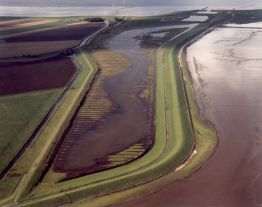Project Aim
The ComCoast project worked on the future approach on safety against flooding around the North Sea. ComCoast aimed to achieve a more gradual transition zone from sea to land, creating benefits for the wider coastal community and environment. In this approach safety and spatial use in the coastal defence zone are combined. From this approach the name of the project originates: Combined functions in Coastal defence zones, which has been abbreviated to ComCoast.
ComCoast studied and investigated the following questions: - Where and when would this concept work well?
- Which costs and benefits are to distinguish and how to deal with socio-economic issues?
- Which technical aspects appear and how can they be solved?
- How to involve stakeholders and general public in developing this new approach?
Project implementation and results
Activities
The project addressed the issue of safety against flooding, applying a multi-disciplinary approach, combining safety against flooding, land-use and economic development encouraged stakeholders to participate. The project work has been divided into six work pack-ages related to reconnaissance of the spatial potentials of the hinterland areas, performance of a socio-economic evaluation of the wetlands, providing a variety of technical solutions for strengthening of the flooding defences; implementing participatory actions; and conducting pilot projects which had been fed from the results from the rest of the work packages.
The project created and applied new methodologies to evaluate multifunctional flood defence zones from an economical and social point of view. A more gradual transition from sea to land creates benefits for a wider coastal community and environment whilst offering economically and socially sound options. The project explored the spatial potentials for coastal defence strategies for current and future sites in the North Sea Region.
The activities focused on the following goals: - Developing innovative technical flood defence solutions to incorporate the environment and the people and to guarantee the required safety level;
- Improving and applying stakeholder engagement strategies with emphasis on public participation;
- Applying best practice multifunctional flood management solutions to the ComCoast pilot sites;
- Sharing knowledge across the Interreg IIIb North Sea Region.
Joint transnational strategy
Sustainability
The project has had several connections to other projects within North Sea Region project portfolio. FLOWS, Escape, ComrRisk, Safecoast and chain of safety in particular. Above all, ComCoast showed to be complementary by choosing to work as much as possible at pilot sites, while most of the other projects focussed more on theory, strategy and policies.
Bottom-up approach
Specialists, experts, consultants were involved in the project development work, in particular in the workshops, surveys and pilot projects. This approach was very fruitful. Involving stakeholders was an important aspect of the ComCoast project. A lesson learned was that it is important to involve stakeholders at an early stage and to let them be involved in the decision-making.
Mode of cooperation
Bringing in practice and experiences from other countries also contributed to a high rate of attention. Experiencing the different approaches of each country is useful. In the Netherlands safety has been organized by law for instance. In this way the Dutch national and regional authorities are obliged to secure a certain level of safety, so there is no specific incentive for instance for the farmers to take measures or to cooperate in finding other solutions themselves. In case the authorities fail to meet with their obligations, people will get compensation. While in the UK farmers have been successfully involved in how to deal with sea level rise and safety measures, just because they do not have any other compensation or alternative.
Impact of the project
Long-term achievements Depending on the regional demands, ComCoast developed tailor-made solutions: - Coping with the future increase of wave overtopping of the embankments;
- Improving the wave breaking effect of the fore shore e.g. by using recharge schemes;
- Creating salty wetland conditions with tidal exchange in the primary sea defence using culvert constructions or by realigning the coastal defence system;
- Coping with the increasing salt intrusion;
- Influencing policy, planning and people
- Gaining public support of multifunctional zones.
Dissemination
The project also has been distributed on DVD in all five participating countries. In total 1.600 DVD´s have been distributed at meetings, seminaries, pilot sites and final at regional events. Furthermore, the project has contributed to a design study of the Hondsbossche and Pettemer Sea Defence on special request of the province of the Noord-Holland in the Netherlands.
|

ComCoast worked on innovative flood protection measures along the North Sea coasts
Partners Ministerie van de Vlaamse Gemeenschap, BE
Carl von Ossietzky Universität Oldenburg (University of Oldenburg), DE
Province of Groningen, NL
Waterschap Zeeuwse Eilanden, NL
Province of Zeeland, NL
Environment Agency, UK
Ministry of Traffic Danish Coastal Authority / Kystdirektoratet, DK
Gemeente Hulst, NL
Waterschap Zeeuws Vlaanderen, NL
LP:
Ministry of Transport, Public Works and Water Management, Directorate General for Public Works and Water Management
Project Manager
Frans Hamer
Ministry of Transport, Public Works and Water Management, Directorate General for Public Works and Water Management
PO Box 5044
NL-2600 GA Delft
The Netherlands
frans.hamer@wldelft.nl
www.comcoast.org
Tel: +31 15 2518 442
Measure: 4.3
Start Date: 27 February 2004
End Date: 31 December 2007
ERDF Grant:
 2.887.769,00 2.887.769,00
Total Eligible Sum:
 5.775.538,00 5.775.538,00
|